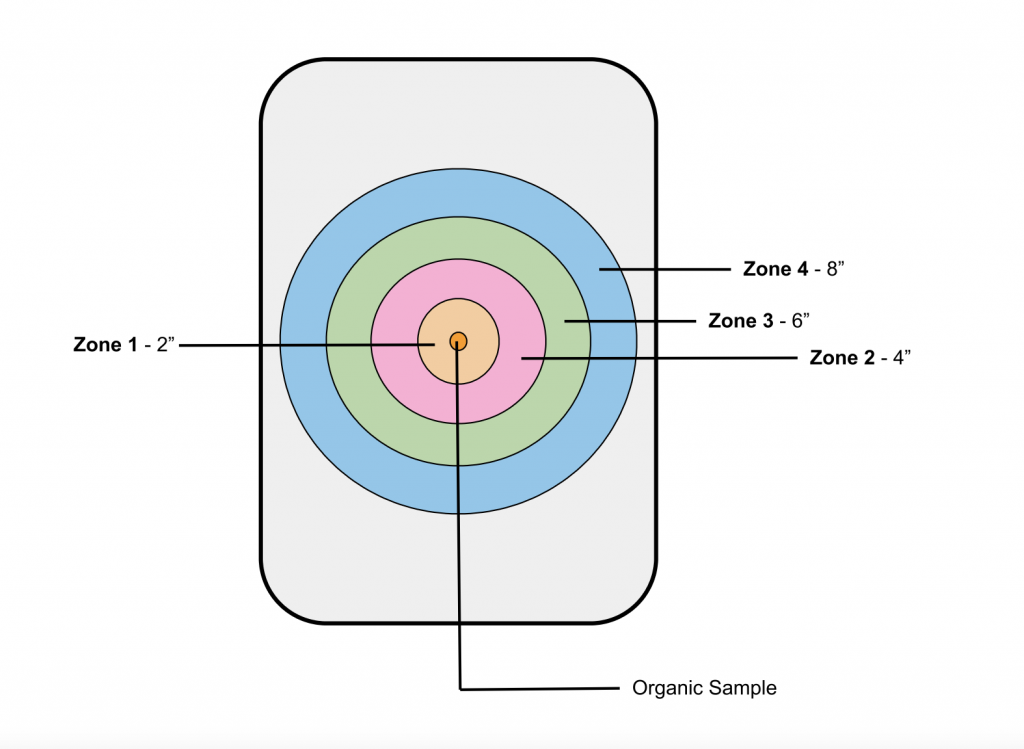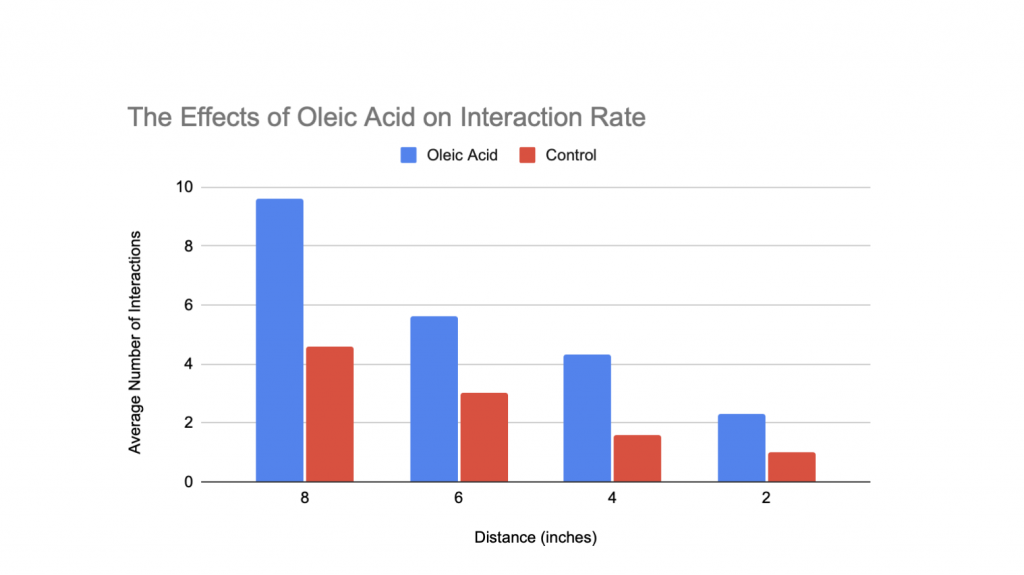Ava Joa, Life Science
Abstract
While pesticides are frequently used to protect crop growth and production in agriculture, if used improperly, they can have harmful effects on the environment, causing pollution of air, water, and soil, as well as unintended harm to non-target organisms. This paper looks at the potential repulsive effects of oleic acid on cockroaches as a small-scale representation of the development of phenomenally based insect repellents for both crop protection and daily use. This was tested by exposing Madagascar Hissing Cockroaches (Gromphadorhina portentosa) to an organic mixture containing oleic acid—the primary component of death pheromones that have previously proven to be repulsive to other insects and measuring the number of interactions with varying radial distances compared to the distances found in a control experiment. However, the data demonstrated that the addition of oleic acid into the organic mixture resulted in a lower minimum radial distance and a higher level of interaction overall.
Introduction
Many insects, particularly social ones, have been known to demonstrate necrophoric behaviours, a sanitary practice of removing dead members of the colony away from the communal living areas to prevent the spread of disease. (Yao et al., 2009). This is because of a release of fatty acids produced during the decomposition process, namely oleic acid. (Yao et al., 2009). Necromones are pheromones given off by dead organisms, which have been demonstrated to incite necrophoric behaviours in social insects (such as ants and termites), as well as necrophobic behaviours in semi-social ones (such as cockroaches and woodlice). (Yao et al., 2009). The ability to recognize their dead allows invertebrates to increase their chances of survival by avoiding areas frequented by predators, as well as bacteria found on decaying corpses. (Yao et al., 2009). An early study on necrophoric behaviour in harvester and fire ants determined that these sanitary behaviours could be triggered solely by the presence of just the oleic acid itself rather than the physical corpse, as well as living ants being treated as corpses after the administration of the acid (Wilson et al., 1958). One study aimed to see whether the desire to pursue sanitary behaviour or the desire to care for the colony’s young was the more pre-eminent instinct. Despite the success of the filter-paper tests, the chemically treated larvae were frequently carried back to their nests rather than be treated as the mature ants had been. (Haskins 1970). This study aims to determine the impact of oleic acid administration on the foraging drive of cockroaches, hypothesizing that the cockroaches exposed to the food mixture that has been treated with oleic acid will have a higher average distance between themselves and the food mixture, and overall reduced foraging behaviour.
Materials and Methods
In a series of six tests (three controls, and three active), groups of 5 cockroaches at a time were placed in a clear plastic tub. During the control tests, a sample of 30 grams of mashed banana was placed on a paper towel and introduced into the plastic tub with the cockroaches. This tub was placed in a dark area to mimic the cockroaches’ natural nocturnal feeding behaviours. A net was placed overtop the tub, and an iPhone camera was placed on top of the net to film the behaviour of the cockroaches from above. They were recorded for half an hour. After each test, the cockroaches were removed from the tub and placed into a separate container to allow them to properly settle in between trials. During the active trials, the banana sample was thoroughly mixed with 5uL of Oleic acid (Westlab). The test was conducted in the same manner as that of the control, where the cockroaches were left in a darkened area with the banana mixture whilst being filmed. After all six trials had been completed, the videos were analyzed through a ‘dartboard chart,’ which used different coloured rings to illustrate the change in radius. The data was collected by measuring the number of interactions with each radial ring, with the interaction count resetting after a cockroach had completely exited the chart, and then re-entered. This meant that if the 3rd zone had been entered, but then the cockroach retreated into the 4th zone before reentering the 3rd, only the first entry into the 3rd zone would be counted.

Figure 1. Diagram of testing tank used in the experiment
Results
Table 1. Cockroach Interactions with radial rings


Figure 2. The effects of Oleic Acid on interaction rate
The raw data from this experiment was then averaged across all six (three control, three active) tests to produce the rates of interaction displayed in the graph above. The aim of this research was to determine whether the introduction of oleic acid into an organic substance would result in an overall decrease in foraging drive, however, the data collected seemed to suggest the opposite. For each decreasing radial ring, the data continued to linearly show a decrease in the minimum distance, however, the oleic acid consistently displayed higher levels of interaction at each radial distance compared to that of the control tests. This refutes the hypothesis that the introduction of oleic acid would reduce overall food drive compared to the control tests conducted.
Discussion
These results show that the average number of interactions increased at every radial distance after oleic acid had been introduced into the organic mixture compared to the control tests. These trends also continued within the log of cumulative time spent eating, with the oleic acid tests resulting in a longer overall time than the control tests. This refutes the previous hypothesis that the oleic acid would deter consumption, and reduce the overall food drive. In addition, this raises the question of whether the oleic acid only serves as an attractor to the cockroaches when added to an organic mixture, or if it would generate the same results entirely on its own, which could be investigated in future experiments. If the latter is true, it could lead to the further development of the efficacy of pheromone-based traps, such as the ones used for yellowjacket wasps. This could also lead to the potential reduction of illnesses and pathogens commonly spread by cockroaches within the home such as intestinal diseases such as dysentery, diarrhea, cholera, and typhoid fever, as well as those spread by bacteria such as salmonella, staphylococcus, and streptococcus (Frothingham., 2020). Unfortunately, only six rounds of testing were able to be conducted, however, in future experiments more trials would be run to ensure more accurate results, as well as altering the amount of oleic acid added to the organic mixture across several tests. An additional possibility of error was the setup of the testing tank, which did not replicate the natural habitat of the cockroach, and so may have led to higher stress responses, leading to abnormal results. In addition, the same five cockroaches were not used in every test, rather the most active ones available were chosen for examination. This could have altered the results due to the cockroaches tested already displaying higher levels of activity on a general basis. Future research could seek to understand the reasoning behind the cockroaches’ attraction to oleic acid in comparison to the generally repulsive effect it has on other insects, both social and solitary.
References
Environmental Protection and Pesticides. BC Ministry of Agriculture, Apr. 2017, https://www2.gov.bc.ca/assets/gov/farming-natural-resources-and-industry/agriculture-and-seafood/animal-and-crops/plant-health/environmental-protection-and-pesticides.pdf.
Frothingham, Scott. “Are Cockroaches Dangerous? What To Know.” Edited by Debra Sullivan, PH.D, Healthline, Healthline Media, 27 Jan. 2020, https://www.healthline.com/health/are-cockroaches-dangerous.
Haskins, C. P. 1970. Researches in the biology and social behavior of primitive ants. Pp. 355-388 in: Aronson, L. R.; Tobach, E.; Lehrman, D. S.; Rosenblatt, J. S. (eds.) 1970. Development and evolution of behavior. San Francisco: W. H. Freeman, xviii + 656 pp.
Wilson, E. & Durlach, N. & Roth, L.. (1958). Chemical Releaser of Necrophoric Behavior in Ants. Psyche, Camb.. 65. 10.1155/1958/69391.
Yao, M., Rosenfeld, J., Attridge, S. et al. The Ancient Chemistry of Avoiding Risks of Predation and Disease. Evol Biol 36, 267–281 (2009). https://doi.org/10.1007/s11692-009-9069-4